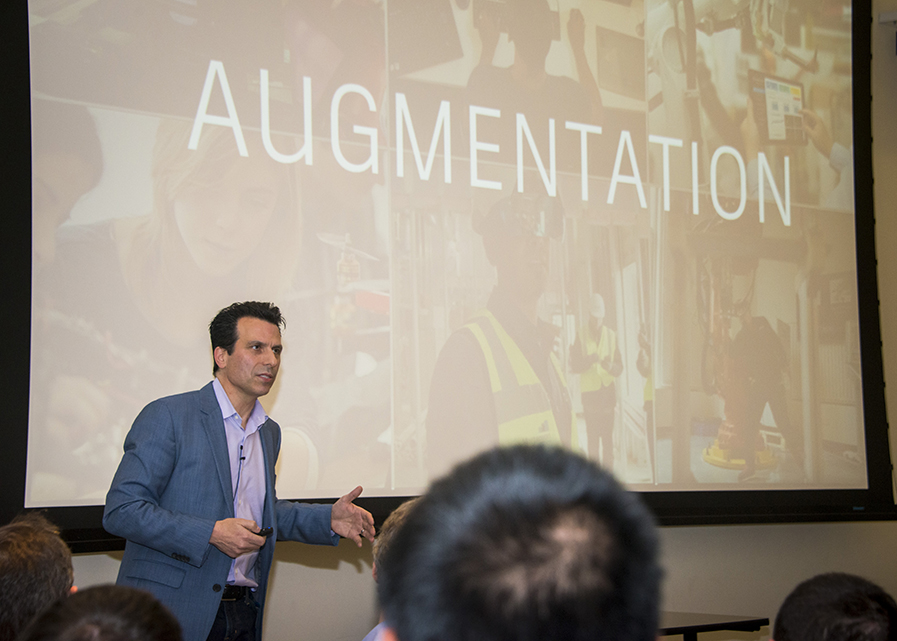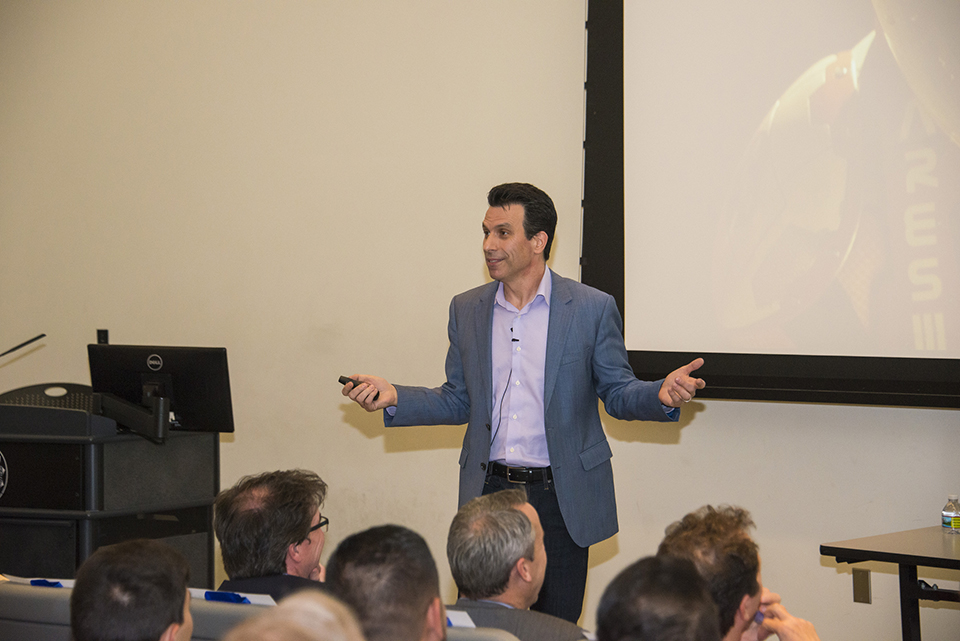Alumnus CEO Anagnost: The Future is About Finding Skills to Thrive and Grow
For Andrew Anagnost, president and CEO of ubiquitous design and engineering software firm Autodesk, the path to success was lit by a notable failure on his California State University, Northridge senior design project.
At the time, Anagnost ’87 (Mechanical Engineering) was a co-op student working with composite materials at the Lockheed Martin Aeronautical Systems Company development center. As his CSUN team worked on their Human Powered Vehicle project, Anagnost suggested they make the vehicle’s fairing — an outer shell — out of composite materials, which would be lightweight and aerodynamic.
A great idea, but there was a problem: when they poured their carbon fiber material into the Styrofoam mold and placed the fairing in a giant oven to set, they had not removed all the moisture, and the composites expanded and cracked in the heat.
“The composite fairing was a total failure, but an amazing learning experience about balancing innovation with what you need to know to execute,” Anagnost said. “Your own personal journey of discovery and amazing things starts right here at CSUN. That was absolutely true for me.”
That project, Anagnost told an audience of approximately 100 CSUN students, professors and alumni on April 26 in Kurland Lecture Hall, contained all the lessons Anagnost needed to succeed in roles as an engineer, a marketer and a CEO. Throughout his talk, titled A Journey to the Future of Making Things, Anagnost, who minored in computer science at CSUN, frequently returned to the lessons of that project to reinforce his message.
It was a funny, informative and inspirational presentation that included photos of Anagnost’s 1980s fashions, CSUN’s role in propelling him into a successful career, the role of automation in the future of design and engineering fields, and tips on how students can prepare themselves for the new careers that will be necessary in an age of automation.
“The real discussion of automation is not about scarce jobs, but having the right skills to thrive and grow,” said Anagnost.
In 2017, Anagnost’s 20-year rise through Autodesk culminated in his selection as president and CEO. Anagnost held numerous positions at the company — leading teams of software developers, helping to transition software and services into the cloud, shifting the business-model to be subscription-based. The common denominator of these positions was change.
Autodesk software has been used to design bridges, roads and buildings such as One World Trade Center in New York City, for special effects in movies such as Avatar and the Harry Potter series, and for designing popular video game series such as Call of Duty and Halo.
Autodesk’s popular programs include Fusion 360 for manufacturers, Maya for computer animators and Revit for architects and structural engineers.
“It’s basically used in all engineering majors,” said Rifaat Kouaider, a computer engineering senior who attended the presentation. “If you’re going to design any kind of technologies like devices, machines, microprocessors, you’re going to need to use their software and present it to your professors and managers in the future.”
CSUN professors helped launch Anagnost’s career by helping him get his co-op job at Lockheed, where he was a small part of the team that wrote algorithms for a supercomputer that was an early version of the cloud.
His professors also wrote recommendation letters to help him get into Stanford University, where he earned a Ph.D. in aeronautics and astronautics, and earned a National Research Council fellowship at NASA Ames Research Center. There, he worked on the Mars Pathfinder rover, developing a simulation of air flow around the craft as it went into the Martian atmosphere. The Pathfinder was largely overshadowed by NASA’s Curiosity rover, Anagnost said, at least until the movie The Martian was released.
“I can honestly say that I worked on the rover that saved Matt Damon,” he said.
CSUN also helped him formulate his leadership philosophy of courage, scholarship and empathy, which could largely be illustrated with his Human Powered Vehicle senior project.
“First is the courage to do things that might not work, like try to do carbon fiber for the fairing,” Anagnost said. “Then there’s this important piece of scholarship; make sure you know what it takes to get it done, but understand what could happen if you get it wrong, like paying attention to the fact that plaster cracks at 140 degrees when it has too much moisture in it. It expands, it cracks, it pops.”
He also elaborated on empathy.
“You have to understand the impact of the decisions you make on people,” he said. “You don’t stop doing what you’re doing because someone might have a bad day. But if you understand the impact, you can get them more engaged in the outcome. For instance, helping people understand we’re going to try to do a carbon fiber fairing, and if we don’t get there we’ll just do it out of Styrofoam. You know that somebody is going to be staying up really late at night cutting the Styrofoam to turn it into fairing two days before we’re actually competing in Reno for the Human Powered Vehicle Competition.”
The human impact is also why Anagnost said his company has a moral obligation to help people whose lives will be disrupted by increased use of automation. Although some jobs will be displaced, others will take their place. For example, the rise of online banking apps is reducing the number of bank teller jobs. But software developers were needed to create those apps.
Engineers, manufacturers and software developers who can efficiently make things will be in demand in the coming decades, as the world’s population approaches 10 billion people. With that growth comes the pressure to improve processes, and to dramatically reduce waste and the need for raw materials.
Autodesk is currently automating several time-consuming processes, including the creation of geometry in engineering designs. The company is also working on tools to help its customers build buildings the same way airplanes are created — in a series of pre-manufactured components that are assembled at the construction site, which would dramatically reduce materials waste.
“We’ve really bought in to this idea of building more, better, with less negative impact,” Anagnost said. “The world can’t handle more, but more is inevitable. That’s why I think automation can actually save us.”
Hamid Johari, interim dean of CSUN’s College of Engineering and Computer Science, called Anagnost a great role model for CSUN students. “It’s very important for engineering students to see that one of their own has made it this far in the world, and how the lessons they learn at CSUN can help them in their future careers,” he said.
The automated world of the future will need computer scientists, mechanical engineers and people with well-rounded backgrounds who can see the big picture. Speech classes are important, as is the ability to tell stories, he said.
He urged students to work in the real world to find out what they love and what they are good at. Above all, Anagnost asked his audience to remain flexible and look for ways to use their skills to make an impact. He said he didn’t start his career planning to work at Autodesk, or to be a CEO, but always pursued the opportunities that enabled him to make a difference.
“Don’t try to plan your course by imagining taking a path that leads to some grand outcome,” Anagnost said. “I encourage you to choose the path that you feel like you can make a difference on, something that ignites your passion and really, really consumes your abilities. And I think great things will happen to you.”





 experience
experience